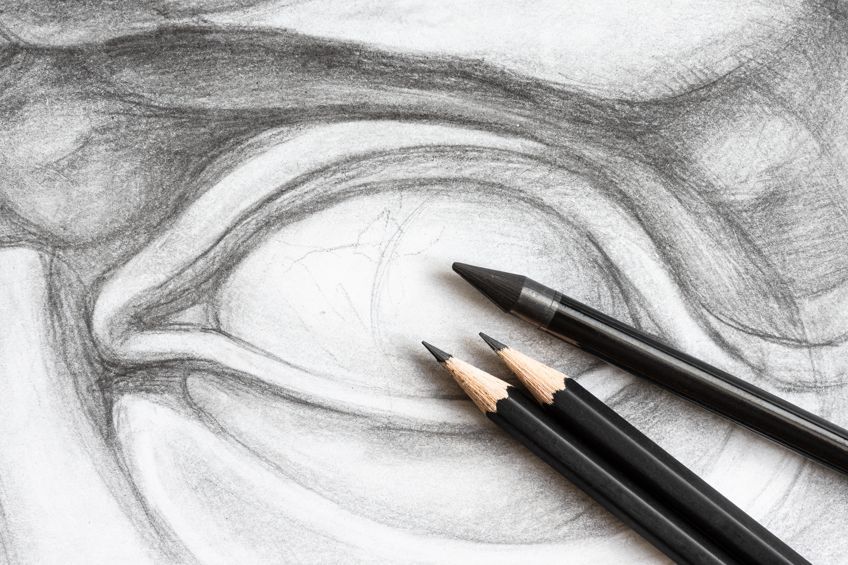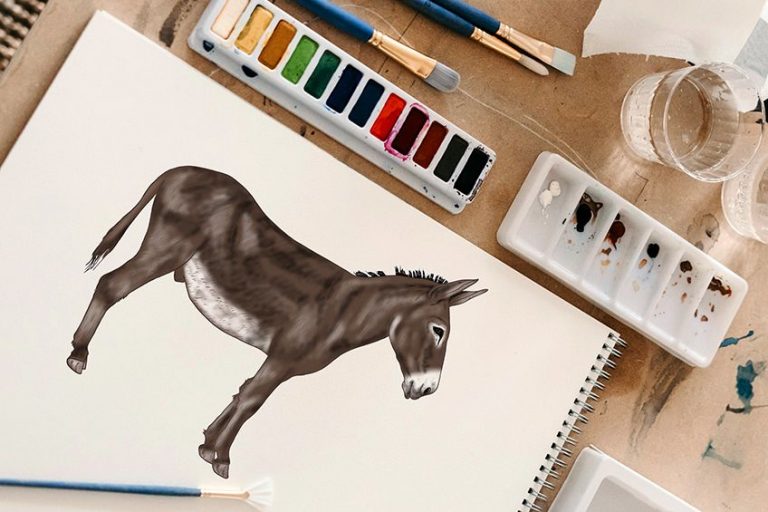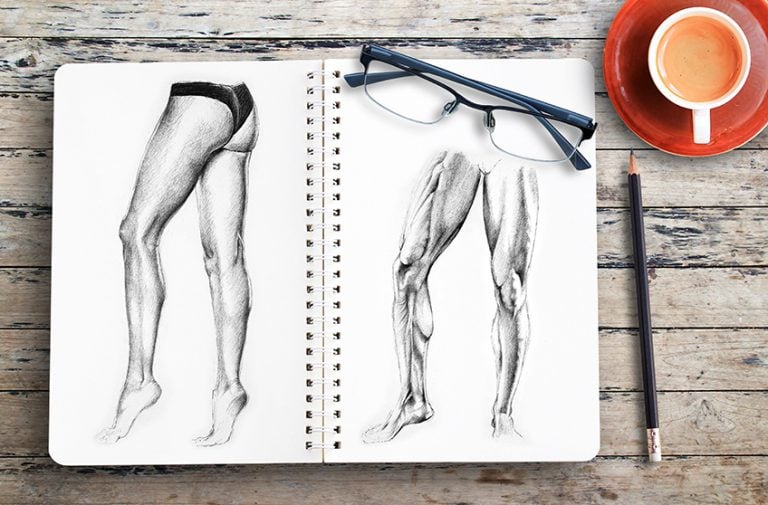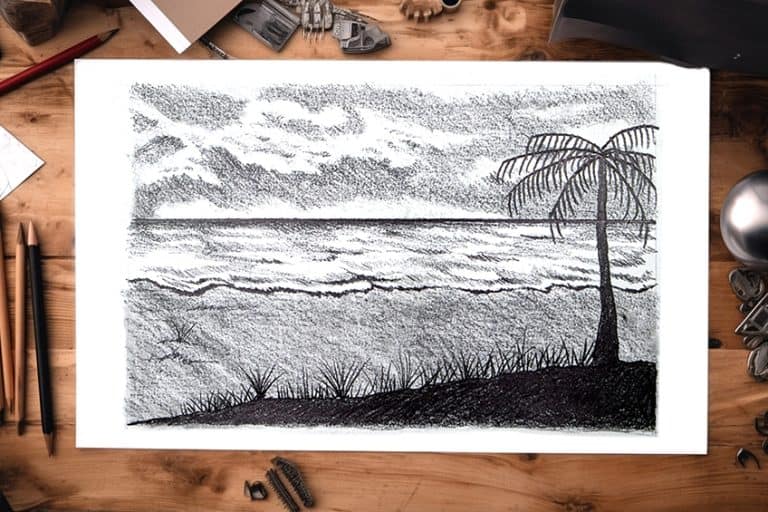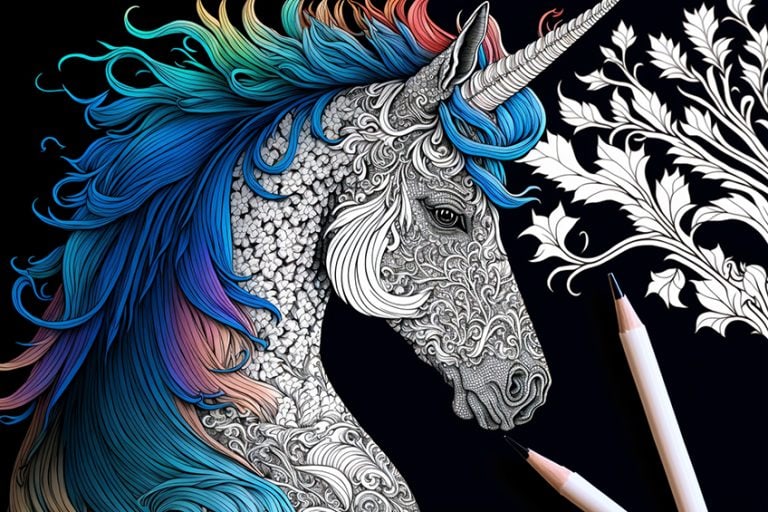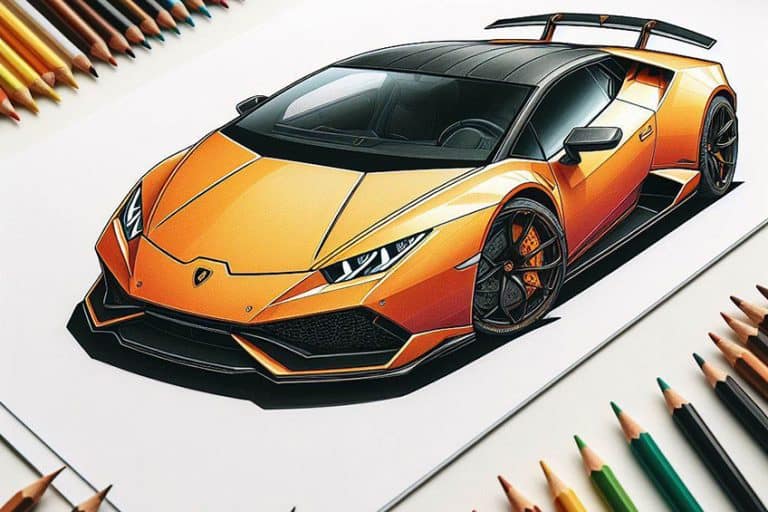Types of Pencils – Exploring Different Pencil Types for Art
Irrespective of your age, even from two or three years old, we have all used a pencil for some reason or another, it may have been just to jot down information on a pad of paper, to sketch, or just create doodles. However, have you ever considered the diversity and types of pencils available? In this article, we will be guiding you through all the available pencil types, and what you can use them for.
Pencils and Where They Came From
Pencils are one of the most popular writing and drawing instruments and are available in a variety of different pencil types. Pencils are used by millions each day, but have you ever wondered where the pencil came from?
The very first pencil was discovered by the Romans and was called a stylus, and they used it as an effective writing tool. The stylus was a thin metal rod that gave stability in creating a readable mark that the scribes used to deposit on the papyrus.
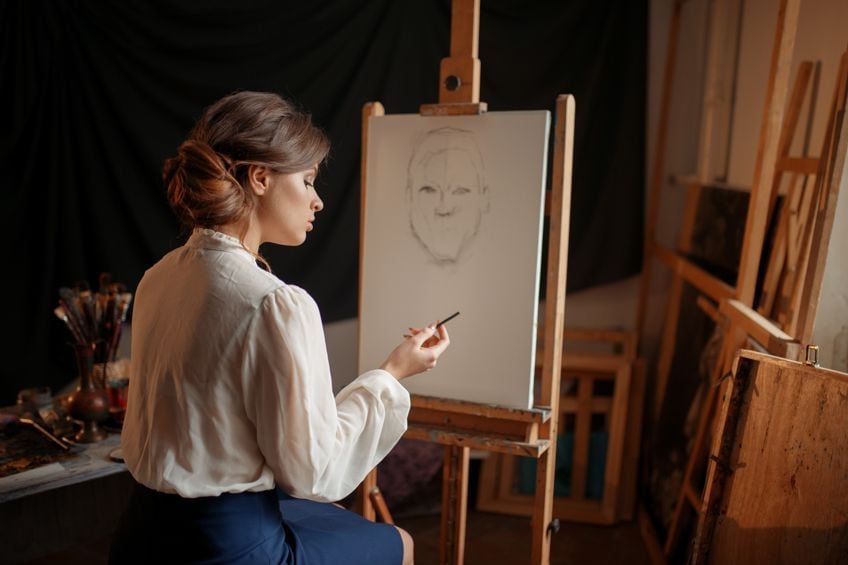
Over the centuries, the pencil continued to evolve and the use of charcoal for the pencil’s core made them more efficient. When a huge deposit of graphite was discovered in Borrowdale, England, during the 1560s, graphite became the core for the pencil. However, the graphite was very brittle and soft and needed a proper holder to contain it.
First, the graphite sticks were wrapped in strings, but later on, the graphite sticks were accessible in a wooden case, making it the first wood-cased pencil. History teaches us that the very first mass-produced wood-cased pencils were manufactured in Germany in 1662, and soon afterward, companies like Staedtler and Faber-Castell also began producing wood-cased pencils.
In 1795, a scientist by the name of Nicolas-Jacques Conte, who served in Napoleon’s army, invented the modern pencil we use today.
What’s In a Pencil?
A pencil is a writing tool that we use for drawing or writing on paper, or other surfaces. A pencil is gray or black and whatever you write or draw with it, can easily be erased. But what’s in a pencil? We have all heard the term “pencil lead”, but surprisingly enough, there is no lead in a pencil at all. A pencil contains graphite, which is a form of carbon that is perfectly suited to sketching pencil types. Today, a pencil consists of a graphite and clay rod encased in a wooden frame. When used, the graphite goes onto the paper where it stays.

As soon as the graphite rod gets blunt, you can sharpen the pencil by cutting away a certain section of the wooden casing, and the pencil is ready to be used again. However, a pencil is a disposable writing or drawing tool, and as soon as the pencil becomes too short, you can discard it.
Pencils are made with various degrees of hardness, depending on what ratio the graphite has to the clay. The more graphite that it contains, the softer and darker the pencil, but when there is a larger portion of clay, the pencil becomes harder and lighter.
Grades of Pencils
From the time the pencil industry began growing, different kinds, grades, and types of pencils were manufactured. Each one was graded and categorized according to hardness levels as well as the quantity or extent of black color it could produce. This means that they were categorized relating to how dark or light they were, and also how light or heavy their lead was.
Below are the types of pencil leads and their different grades.
B-Grade Pencils
The B-grade pencils can produce darker lines than the F and H-grade pencils, and you can easily erase the lines without putting in much effort. The ability of the B-grade pencil to produce darker lines is because they are much softer and as such, they can leave darker graphite lines on your paper. These B-grade pencils are ideal for taking notes and doodling. These are also ideal types of drawing pencils.
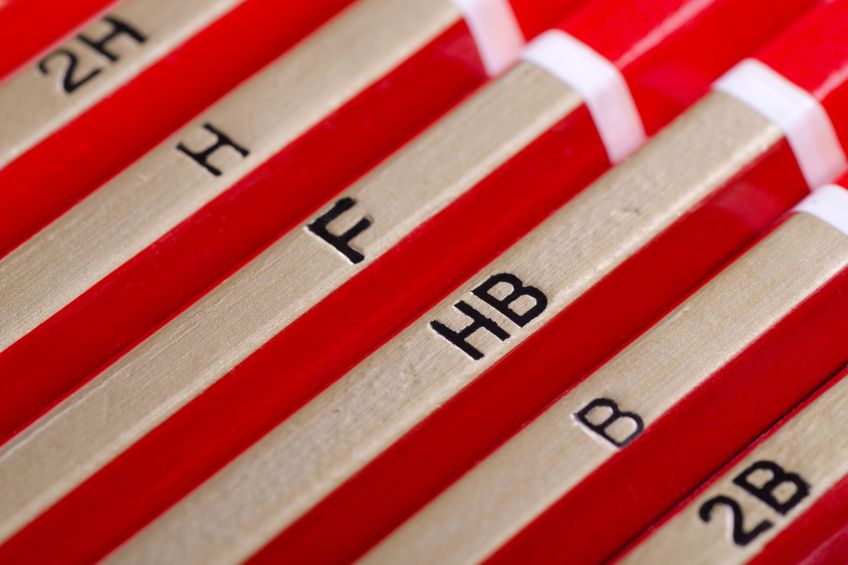
The 8B Grade Pencil
This grade of pencil leaves an extremely dark line on your paper and is the darkest of all the B-grade pencils. This grade of a pencil is best used for sketching pencil types and drawing as it leaves very dark prominent lines on your paper, making perfectly visible marks and lines on your drawing sheet.
The 7B Grade Pencil
The 7B grade pencil is similar to the 8B as it leaves a dark gray shade on your paper, and drawings look amazing on the paper. It is also ideal for all art-related projects like drawing or sketching. When using this grade of pencil, you can expect amazing images that are complemented by dark features.
The 6B Grade Pencil
The 6B grade pencil is considered the best graphite drawing pencil on the market. The pencil is best used for drawing purposes and especially when you want to add some dark values to your drawing.
It is the perfect tool to use when creating portraits and if you want to accomplish a realistic texture such as fur, fabric, or skin in your drawing.
The 5B Grade Pencil
With this grade of pencil, the number indicates the softness of the pencil. This means the higher the number of the B-grade pencil, the softer it will be. Therefore, the 5B grade pencil will be softer than a 4-grade pencil. This particular grade pencil makes darker lines and marks on your paper, and it can be used in various types of applications, but the most common is drawing and note-taking.
The 4B Grade Pencil
This pencil makes lighter marks and lines on your paper but will still be able to bring out those amazing images from your drawing. If you love drawing and sketching, then this pencil will provide a stress-free drawing experience.
The 3B Grade Pencil
The 3B grade pencil is very much a mixture of light and dark, the shades of light seem to dominate the darker shades, and the lines or marks it leaves on your paper lean more toward the lighter gray. This pencil is ideal if your drawing features and the light values also have slightly dark gray shades.

The 2B Grade Pencil
This pencil is ideal for dark to medium shading as it provides a perfect range of value or tone. The pencil can go from dark to light shading, depending on the pressure you exert when sketching or drawing. This pencil is used a great deal by artists for sketching, shading, and drawing, and is also utilized for writing rough drafts.
HB Grade Pencils
What does HB mean on a pencil? The HB-grade pencil is a perfect classification of what a standard graphite pencil should be, as opposed to the B- and F-grade pencils. It falls precisely in the mid-range of the pencil hardness chart. This is a fairly hard pencil, which makes it not the best choice for drawing purposes. The “H” indicates the hardness of the pencil, and the “B” signifies the blackness of the mark it leaves behind on the paper. The HB grade pencils are ideal types of drawing pencils, normally used for writing and technical drawing.
F-Grade Pencils
The “F” in these types of pencils refers to the fine point of the pencil and in comparison to other pencil grades, it is slightly harder. There is no problem in keeping this pencil sharp, but it is far too dark for everyday use and general drawing.
The F-grade pencils are normally used for writing and technical drawing.
H-Grade Pencils
The letter H in these pencils refers to the hardness of the pencil, which means as the value number of the H increases, so does the hardness. For example, a 4H pencil will be harder than a 2H pencil. It will also indicate that the harder the pencil becomes, the lighter it will be.
This also means that the lighter the marks or lines it leaves behind, the easier it is to erase them from your paper. The H-grade pencils are ideal for extreme precision work in design drawing, but they can be used for sketching and can also be used as a writing tool.
The 2H Grade Pencil
This pencil contains a light amount of lead, which is why it gives you a lighter shade on your paper, and also makes it a lot easier to erase with a lot less damage to your paper. This makes it the perfect type of pencil to use if you are a beginner in the art of drawing. If you want to add some light shades to your drawing, then this pencil is the one to use.
The 3H Grade Pencil
This pencil leaves a very light mark or line o the paper because it is comprised of light shades of gray. This pencil grade is ideal for sketching where you want only light shades, and can also be used for filling in empty spaces in your project.
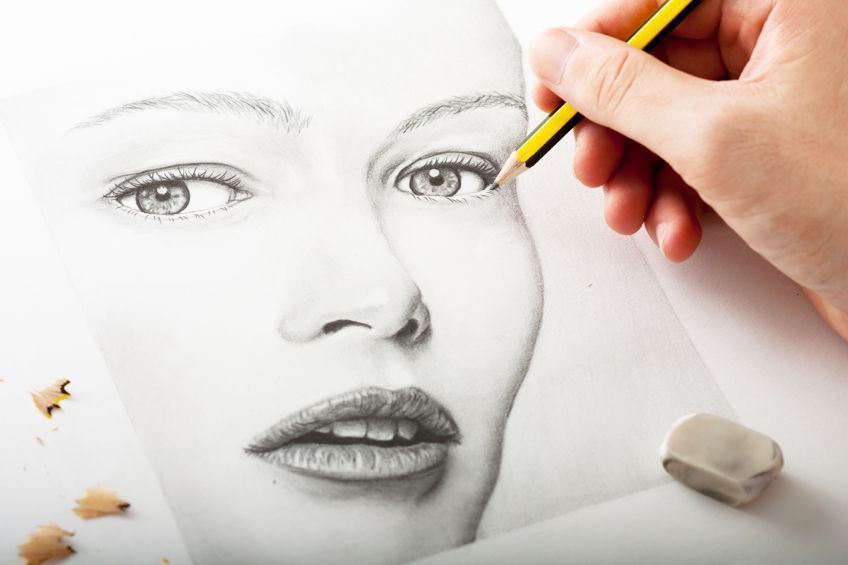
The 4H Grade Pencil
If you are looking for a fine pencil that can give you even shading and fine lines, then the 4H grade pencil is the one to use. This type of pencil is very effective in producing characters that appear less shiny due to the amount of clay that it contains. It is also very easy to keep sharp and reduces the frequency of using your pencil sharpener, and is perfect for shading and sketching.
The 5H Grade Pencil
You can create dark and thin lines with this pencil due to its hardness level, which falls towards the end of the hardness scale. So, whenever you require a dark thin line, then this pencil is the one to choose. It is a perfect option for sketching and drawing and is also ideal as a mechanical pencil.
The 6H Grade Pencil
This pencil has the highest hardness level of all pencils and can give you the darkest and thinnest lines on your paper. This is a top-quality pencil and is ideal for sketching, drawing, writing as well as other technical and artistic applications.
Below is a summary and pencil hardness chart.
| Grade | Degree of Hardness | Best Used For |
| 9B | Very Soft | Drawing, sketching, and shading |
| 8B | Very Soft | Drawing, sketching, and shading |
| 7B | Very Soft | Drawing, sketching, and shading |
| 6B | Very Soft | Drawing, sketching, and shading |
| 5B | Soft | Drawing, sketching, and shading |
| 4B | Soft | Drawing, sketching, and shading |
| 3B | Soft | Drawing, sketching, and shading |
| 2B | Soft | Drawing, sketching, and shading |
| B | Soft | Drawing, sketching, and shading |
| HB | Medium | Writing as well as technical drawing |
| F | Medium | Writing as well as technical drawing |
| H | Hard | Marking crafts and technical drawing |
| 2H | Hard | Technical drawing |
| 3H | Very Hard | Technical drawings and detailed technical drawings |
| 4H | Very Hard | Technical drawings and detailed technical drawings |
| 5H | Very Hard | Technical drawings and detailed technical drawings |
| 6H | Extremely Hard | For very special purposes |
| 7H | Extremely Hard | For very special purposes |
| 8H | Extremely Hard | For very special purposes |
Types of Pencils
The pencil seems to be an integral part of everyone’s life, from the scholar and student to the artist, and the general office worker. Each of these people needs different pencil types. There are pencils for drawing, writing sketching, and for general use at home. Some of them have a wood casing, while others have a metal barrel. You need to select the right types of pencils that suit your particular needs.

Graphite Pencils
The graphite pencil is the most common of all the different pencil types and is what most of us are all familiar with. Lead or graphite is made from a mixture of clay and graphite, and depending on the amount of these two materials, it will determine the darkness and hardness of the pencil.
For example, if more clay is used in the mixture, then the marks made will be much lighter and harder.
If it contains more graphite, then the marks will be darker and a lot softer, and the faster the pencil will wear down. With this graphite type of pencil, the lead is encased in wood. This pencil allows the artists to draw expressive lines, and make light guidelines and realistic images, it also allows for smoother strokes.
Solid Graphite Pencils
The solid graphite pencil also referred to as a woodless pencil, is a pencil that consists of solid graphite without the wooden casing like a normal pencil. The diameter is similar to an ordinary pencil with a wooden casing. The advantage of this pencil is that it can cover a larger area in a lot quicker time. The pencil can also create different effects and is more economical as you use the entire pencil. These pencils are also available in the same hardness and grades as the ordinary graphite pencil and are used mainly by artists for drawing and art.
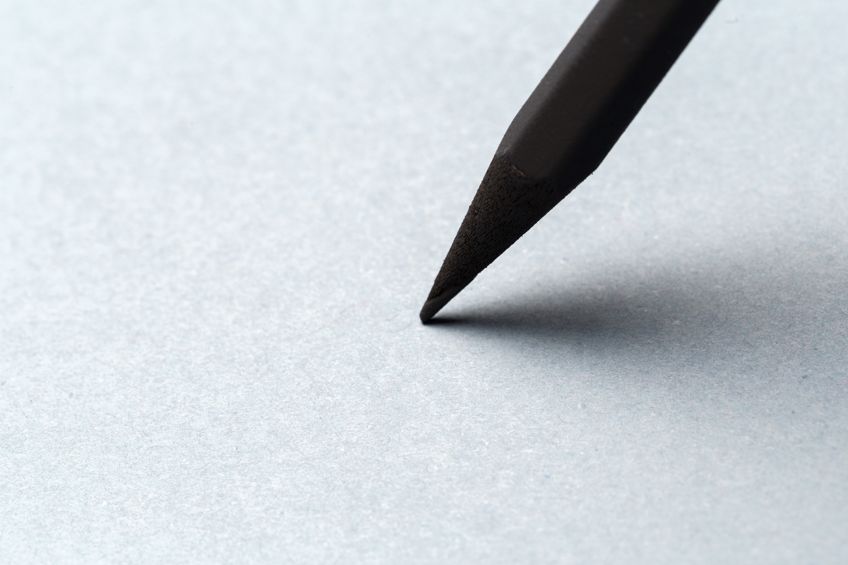
Liquid Graphite Pencils
Liquid graphite pencils were first invented in 1955 and are also referred to as “Liquid Lead” as they can write like a pen. The liquid graphite pencils come in different shades like yellow, red, blue, and gray. You can use a nib, brush, or any other type of art tool to apply it. The liquid graphite pencil is used by artists to create pencil sketches and genuine graphite pencil effects using a liquid.
Manufactures like Doman and Scripto developed a ballpoint pen that used liquid graphite which allowed the user to erase the marks and writing.
Charcoal Pencils
The charcoal pencil is made entirely of charcoal and can create high contrast and rich tones, better than the graphite pencil. However, it smudges fairly easily and is a lot more abrasive on your paper than the graphite pencil, and is a lot more brittle. This type of pencil is perfect for writing as it is very easy just to wipe off the charcoal from your paper if you make a mistake.
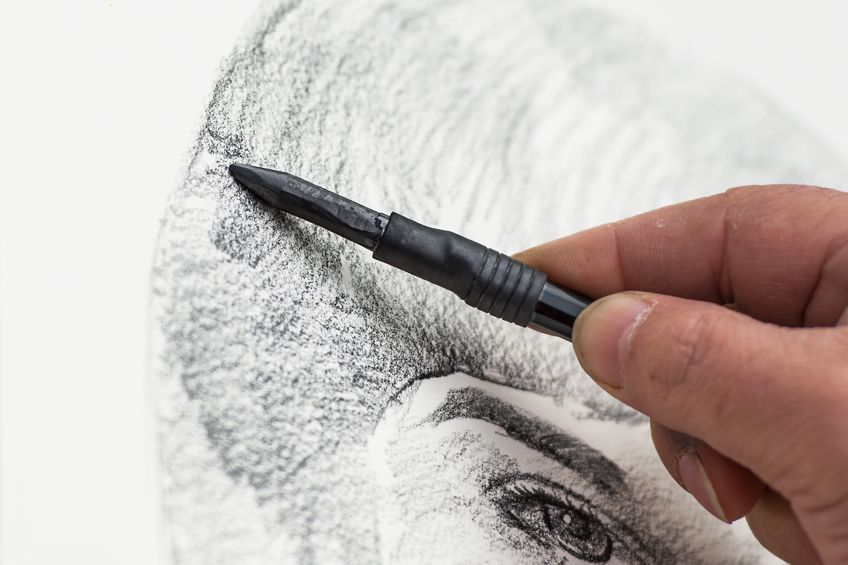
The charcoal pencils come in various styles, like paper-wrapped charcoal, wooden charcoal, or white charcoal pencils, and are used for creating photo-realistic drawings and finely detailed drawings. This helps prevent an artist’s hand from being marked. Many famous artists made use of the charcoal pencil, for example, Georgia O’Keeffe, Leonardo da Vinci, Ernst Barlach, and Michelangelo.
Carbon Pencils
The carbon pencil is made from a mixture of lamp black and clay, or a blend of graphite and charcoal, and has a uniform and reliable softness that has exceptional texture and blending capabilities. The carbon pencil produces thick and deeper black lines than the graphite pencil, which are difficult to erase.
However, these pencils are smoother than charcoal and leave a minimum amount of dust and smudging.
Colored Pencils or Crayons
Colored pencils are made from colored pastels, chalk, and charcoal with an oil or wax-based core that contains binding agents, additives, and pigments. There is also a water-soluble pastel or colored pencil available. They come in a wide range of colors including white, which is perfect for giving shadow or lightening darker colors when creating a drawing. These pencils are often used by architects and children for drawing and coloring, as they are easy to use and are non-toxic.
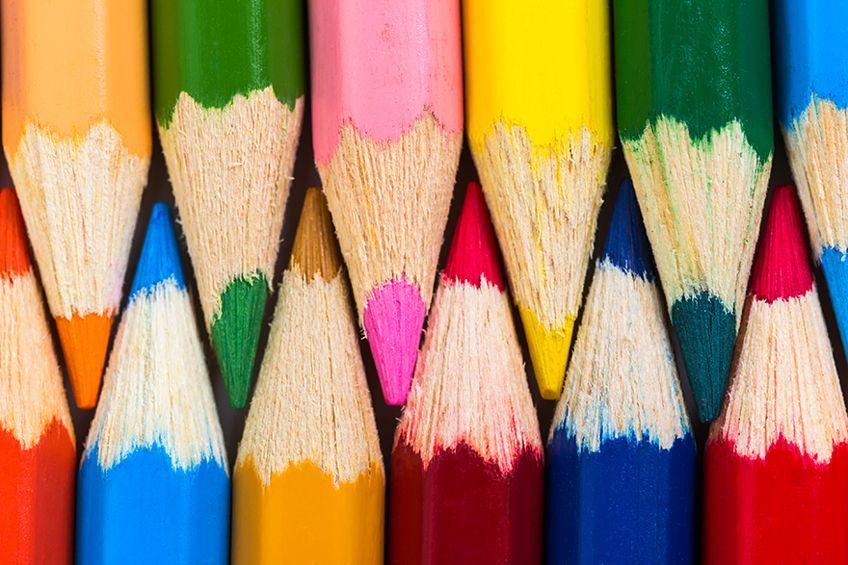
Grease Pencils
The grease pencil also referred to as a China marker, China graph pencil, or wax pencil, is normally encased in paper or wood and is made from hardened colored wax. These types of pencils are perfect for use on glossy non-porous surfaces like glass, porcelain, rock, plastic, ceramics, metal, and polished stone.
They are also ideal for editing tapes, films, and marking on x-rays.
Due to its ability to write on glass, it is used extensively in the chemistry laboratory for writing on glass and is also used in the construction sector as a marking tool as it does not scratch the surface. Some artists also prefer using the grease pencil as it can write on wet surfaces.
Watercolor Pencils
The watercolor pencil also referred to as “The Water-soluble Pencil” is a very versatile pencil as it can be used in a dry state like a normal pencil, and produces bold sharp lines. However, it can also be used in a wet state, where it will produce a watercolor effect, and can be spread by using a brush.
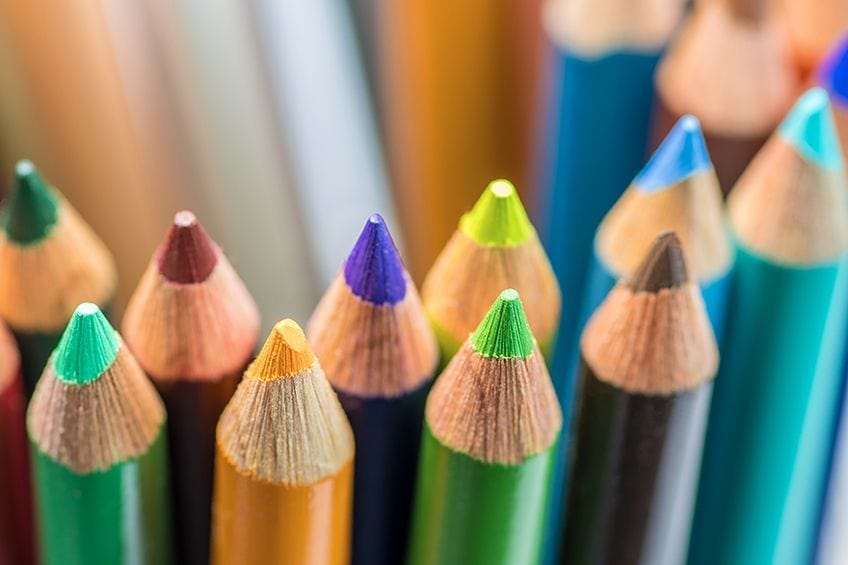
When used in its wet state, artists will first lay down some dry pigment, and then follow it up using a damp brush. This helps spread the pigment, which intensifies the colors. There is also a technique you can use with this pencil that can blend the colors on your artwork piece. The artist-grade watercolor pencil comes in 60 to 72 different colors, and some brands have as many as 120 assorted colors.
Copying or Indelible Pencils
The copying or indelible pencil, also referred to as a chemical pencil, was first invented by K. Puscher in 1857. The pencil was then patented in July 1866 by Edison Clark, and was extensively used until the middle of the 20th century when it was replaced by the ballpoint pen.
The lead of these pencils was made by adding some dry water-soluble permanent dye with the powdered graphite and then mixed with the clay.
The pencil is effective when the lead is wet with some saliva and then applied to the paper, leaving a permanent or indelible mark. The pencil is used for copying or duplicating documents, where a permanent mark is required, such as financial documents, but can also be used on other substrates such as wood and even the skin. However, the one disadvantage of this pencil is that it is very sensitive to moisture and the dye can easily ruin the paper.
Mechanical Pencils
The mechanical pencil is similar to the ballpoint pen and comes with a metal or plastic frame. The lead is then pushed through a hole at the point of the pencil frame when you click the pencil. They are manufactured with two different types of mechanisms; the propelling pencil where the internal mechanism forces the lead out of the frame.

The clutch pencil simply holds the lead in place, and when the button is depressed, the lead is automatically released. The lead comes in various sizes from 2.00 mm (0.079 inches) to, 0.013 mm (0.0051 inches). Here are some advantages of a mechanical pencil:
- There is no need to sharpen the pencil
- The point of the pencil remains sharp
- The length of the pencil remains constant
- The mechanical pencil is environmentally friendly
Erasable Coloring Pencils
Unlike wax pencils, erasable colored pencils can be erased. They are also useful as their markings stand out, and for this reason, copy-editors prefer them. They can be used to create an outline, and then later you can use colored wax-based pencils or watercolor paints to fill in, making this pencil perfect for sketching.
Since they do not smudge easily, some animators prefer to use them.
Plastic Pencils
The plastic pencil was invented by Harold Grossman in the late 1960s, and Dr. Arthur D. Little improved on them in the early 1970s. The core of these pencils is made of aluminum stearate, wood flour, and ABS plastic. These pencils are very flexible and can bend easily without breaking, and as they are extruded by machine, they do not have a seam or a grain.
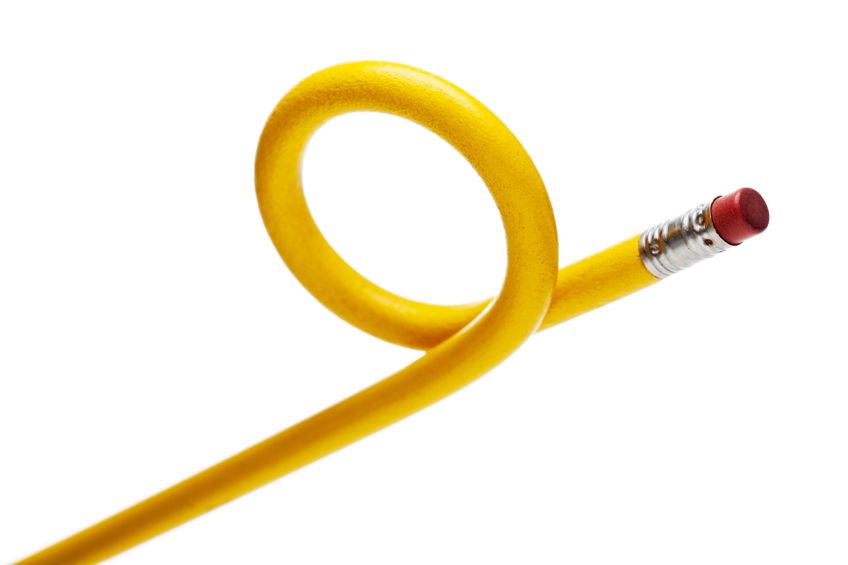
Stenography Pencils
The lead of the stenography pencil also referred to as steno pencils, is break-proof and is very reliable. Sometimes these pencils are sharpened at both ends, which improves their reliability. They are also round, which helps to relieve any pressure or pain during long hours of working.
Golf Pencils
The golf pencil is also referred to as a library pencil, as libraries offer them to students as a disposable and leak-proof writing instrument. As its name implies, it is used for keeping score in a game of golf and is a very cheap and short pencil at about 3.5 inches long. Since they are so short and cheap, they are ideal for use by small children as they can use them to practice writing figures and letters.
They are also used in places of worship like churches, restaurants, lottery tickets, weddings, and any other type of ceremony, where they are used very briefly.
Carpenter Pencils
A carpenter pencil that was used by German carpenters dates back to the 17th century and is now the oldest pencil that Faber-Castell has in their collection. This pencil has two main properties, its shape that it has and the strength of the graphite. The pencil is rectangular, which makes it easy to grasp and stops the pencil from rolling around. The tough strong lead allows you to draw easily on stucco or cement-based colored plaster, rough wood as well as sheets of wood like plywood. The lead is easy to sharpen by using a razor-edged tool or box cutter.
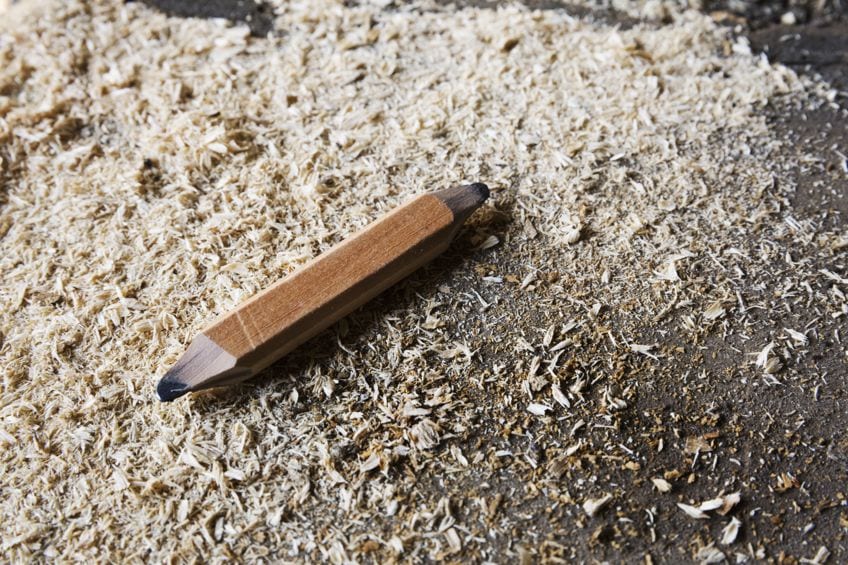
Not all pencils are the same, as they differ from manufacturer to manufacturer, so you as an artist should find the right pencil brand that is best suited for your needs. We hope that this article and list of types of pencils will help point you in the right direction.
Frequently Asked Questions
What Pencil Type Is Best for Construction?
The 2H pencil is ideal for dimensional lines and drawing, whereas the H pencil is perfect for object lines and lettering. The HB pencils are ideal for boundary lines as they leave a fine and dark line on your paper.
What Is the Best Beginner Drawing Pencil?
If you are just starting with your drawing experience, then the best pencil, to begin with, will be a 2B or 3B pencil as they give you the right shade configuration, and you can later progress to the 6B or 9B pencil that gives you darker shades. If you want, you can also use colored pencils.
What Type of Pencils Can You Use for Shading?
You need to use softer pencil types, so the B-grade pencils are ideal for shading. However, you can still use a harder pencil like the H type. If you are after lighter and more delicate shading, then your best pencil to use will be the HB and H grade pencils.
What Does HB Mean on a Pencil?
Soft lead pencils are usually graded using the letter B, which indicates how dark the mark will be. Harder lead is graded by using the letter H, so then the letters HB on a pencil give you a happy medium in the middle of the graphite hardness scale.
Matthew Matthysen is an educated multidisciplinary artist and illustrator. He successfully completed his art degree at the University of Witwatersrand in South Africa, majoring in art history and contemporary drawing. The focus of his thesis was to explore the philosophical implications of the macro and micro-universe on the human experience. Matthew uses diverse media, such as written and hands-on components, to explore various approaches that are on the border between philosophy and science.
Matthew organized various exhibitions before and during his years as a student and is still passionate about doing so today. He currently works as a freelance artist and writer in various fields. He also has a permanent position at a renowned online gallery (ArtGazette) where he produces various works on commission. As a freelance artist, he creates several series and successfully sells them to galleries and collectors. He loves to use his work and skills in various fields of interest.
Matthew has been creating drawing and painting tutorials since the relaunch in 2020. Through his involvement with artincontext.org, he has been able to deepen his knowledge of various painting mediums. For example, watercolor techniques, calligraphy and lately digital drawing, which is becoming more and more popular.
Learn more about Matthew Matthysen and the Art in Context Team.


